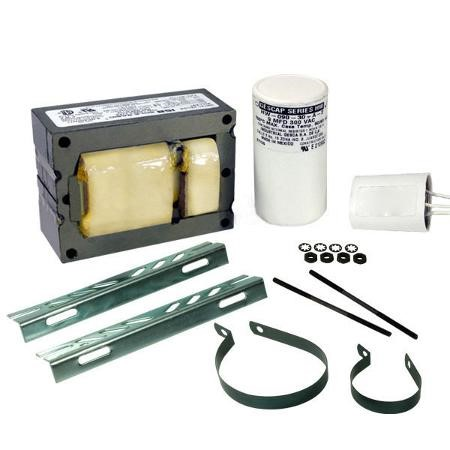The Role of High-Pressure Sodium Ballasts in Outdoor and Industrial Lighting
Posted on Thursday Jan 16, 2025 at 07:50PM in Educational Resources
What Are High-Pressure Sodium Ballasts?
Updated: August 13, 2025
TL;DR: An HPS ballast delivers a high‑voltage ignition pulse to strike the arc, then regulates current so the lamp runs at its rated wattage. Always match the ballast to the lamp’s ANSI code and wattage, verify your supply voltage, and follow the luminaire label and NEC requirements.
Read More (quick take): Parking lot dim or orange‑pulsing? Common causes are a tired ignitor, aging lamp, or a bad capacitor. Use the checks below, grab the right kit, and restore output.
What an HPS ballast does
An HPS ballast does two jobs: it provides an ignition pulse to start the arc, then it limits and regulates current during run. HID ballasts for HPS are evaluated to UL 1029, which covers ballasts, starting circuits, and associated equipment for HID lamps. Electronic HID ballasts exist for HPS; see Intertek’s Standards Update Notice for UL 1029. Magnetic CWA, reactor, and HX types remain common in the field.
Shop parts: see high‑pressure sodium ballasts at Revco.
Where HPS is used
HPS remains typical for roadway, parking, industrial, and some greenhouse lighting because of high efficacy and long life documented in manufacturer data. For example, LUMALUX ECO lists 24,000‑hour average rated life on many models, while Philips Ceramalux non‑cycling variants publish up to 40,000‑hour rated average life (50% survival) depending on type.
Match the lamp to the ballast
Match by wattage and ANSI code printed on the lamp and specified on the ballast kit. Common HPS pairings include: S54 (100 W), S55 (150 W, 55‑V class), S50 (250 W), S51 (400 W), S52 (1000 W). See manufacturer kit tables and quick references such as Halco’s electromagnetic HID table and ANSI code lists.
Pick the right circuit and voltage
Circuit type: CWA ballasts improve lamp wattage regulation when line voltage varies, compared to reactor or high‑reactance circuits. See Advance HID application notes and Venture’s ballast tech pages.
Voltage taps: Many HPS kits are multi‑tap (commonly 120/208/240/277 V, and often 480 V on 5‑tap kits). Verify the building supply before landing leads. Example: Plusrite 7276, S51, 5‑tap 400 W kit.
Ignitors are required for HPS
HPS lamps need a pulse ignitor. Ballast kits list the correct ignitor and the allowable lamp‑to‑ignitor distance; if the ignitor is missing or out of spec, the lamp may fail to start or may cycle. See Advance HID pocket troubleshooting guide and ignitor distance charts (long‑range ignitors are available for remote mounting).
Install and code notes
Follow listing and instructions: Install exactly as shown on the luminaire label and in the kit instructions, per NEC 110.3(B).
Disconnecting means for service: For fluorescent or LED luminaires with double‑ended lamps, a disconnecting means is required; the rule formerly at 410.130(G) was relocated to NEC 410.71 in the 2023 edition. See also Leviton’s Captain Code explainer.
No reconditioned ballasts or drivers: NEC 410.2 prohibits reconditioned luminaires, lampholders, ballasts, LED drivers, lamps, and retrofit kits in 2023. Trade references summarizing the change include EC&M.
AHJ has final say: Local adoption and interpretations vary. Verify with the Authority Having Jurisdiction per NEC 90.4. NFPA and trade articles explain this role, for example NFPA blog on Article 90.
Safety reminder: De‑energize and lock out before opening luminaires or working in wiring compartments. Use PPE and follow your company’s electrical safety program.
Quick diagnostics
Won’t start or starts very slowly: check the ignitor and wiring distance, then the capacitor and lamp.
Repeated cycling after warmup: suspect ignitor or aging lamp, then test the capacitor.
Loud hum, overheating, tar seepage, or visible damage: replace the ballast kit.
Manufacturer troubleshooting guides outline these symptoms and checks; see Advance’s pocket guide.
When to replace or upgrade
Replace the ballast if you see persistent non‑start, cycling, audible noise, overheated components, or insulation breakdown. If the site plans a relight, review an LED conversion rather than one‑off HID repairs; DOE and PNNL reports document energy and maintenance advantages for outdoor area lighting versus legacy HID. See DOE Outdoor Area Lighting fact sheet and a PNNL street‑lighting assessment.
Parts and help
Buy online: browse high‑pressure sodium ballasts.
Power gear for the job: need control or step‑down power? See transformers at Revco.
Visit a counter: check Revco locations and hours.
About Revco
Serving Long Island contractors since 1978 with stocked counters, same‑day options, and people who answer the phone. See our lighting showrooms and stop in.

Tags: #hidlighting #highpressuresodium #industriallighting #metalhalide #outdoorlighting #securitylighting #warehouselighting